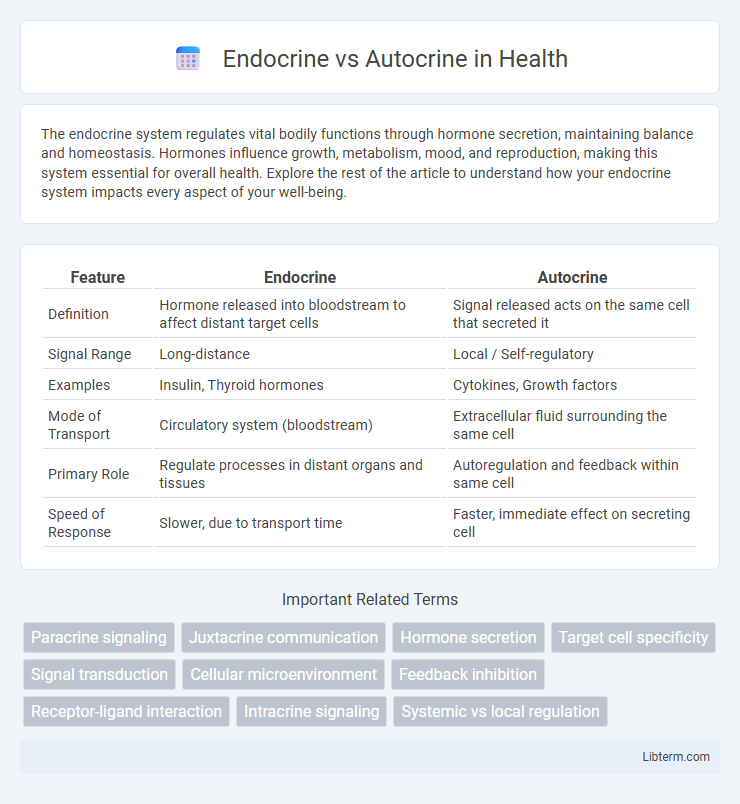The endocrine system regulates vital bodily functions through hormone secretion, maintaining balance and homeostasis. Hormones influence growth, metabolism, mood, and reproduction, making this system essential for overall health. Explore the rest of the article to understand how your endocrine system impacts every aspect of your well-being.
Table of Comparison
| Feature | Endocrine | Autocrine |
|---|---|---|
| Definition | Hormone released into bloodstream to affect distant target cells | Signal released acts on the same cell that secreted it |
| Signal Range | Long-distance | Local / Self-regulatory |
| Examples | Insulin, Thyroid hormones | Cytokines, Growth factors |
| Mode of Transport | Circulatory system (bloodstream) | Extracellular fluid surrounding the same cell |
| Primary Role | Regulate processes in distant organs and tissues | Autoregulation and feedback within same cell |
| Speed of Response | Slower, due to transport time | Faster, immediate effect on secreting cell |
Introduction to Cell Signaling Pathways
Endocrine signaling involves hormones released by glands into the bloodstream, affecting distant target cells with specific receptors, enabling systemic regulation of physiological processes. Autocrine signaling occurs when cells secrete signaling molecules that bind to receptors on their own surface, modulating cellular functions such as growth, differentiation, and immune responses locally. Both pathways demonstrate the complexity of cell communication, with endocrine pathways facilitating long-range signals and autocrine mechanisms providing precise, self-regulated feedback loops within individual cells.
Defining Endocrine Signaling
Endocrine signaling involves the release of hormones by endocrine glands into the bloodstream, allowing distant target cells to respond to the signals. This type of communication regulates physiological processes such as metabolism, growth, and reproduction through hormones like insulin, cortisol, and thyroid hormones. Unlike autocrine signaling, where cells respond to signals they secrete themselves, endocrine signaling coordinates complex systemic functions by targeting multiple organs and tissues.
Understanding Autocrine Signaling
Autocrine signaling involves a cell releasing signaling molecules that bind to receptors on its own surface, enabling self-regulation of cellular activities such as growth, differentiation, and immune responses. This self-communication contrasts with endocrine signaling, where hormones travel through the bloodstream to target distant cells, affecting systemic physiological processes. Understanding the specificity and feedback mechanisms in autocrine signaling is crucial for insights into cancer progression and immune system function.
Key Differences Between Endocrine and Autocrine
Endocrine signaling involves hormones released by glands into the bloodstream to target distant cells, whereas autocrine signaling occurs when cells secrete signaling molecules that bind to receptors on the same cell or nearby identical cells. Key differences include the range of action--long-distance for endocrine and local for autocrine--and the physiological roles, where endocrine regulates systemic processes like growth and metabolism, and autocrine modulates localized cellular activities such as immune responses. The molecular mechanisms differ as endocrine hormones circulate through blood vessels, while autocrine signals rely on direct receptor interactions on the signaling cell itself.
Mechanisms of Hormone Release and Targeting
Endocrine signaling involves the release of hormones by glands into the bloodstream, allowing hormones like insulin or cortisol to travel long distances and affect target cells in different organs. Autocrine signaling occurs when cells secrete hormones or signaling molecules that bind to receptors on the same cell, as seen with growth factors regulating cell proliferation. These distinct mechanisms enable precise control of physiological processes, with endocrine hormones targeting distant cells, while autocrine signals modulate local cell activity.
Examples of Endocrine and Autocrine Communication
Endocrine communication involves hormones released by glands into the bloodstream to target distant organs, such as insulin from the pancreas regulating blood glucose and thyroid hormones controlling metabolism. Autocrine communication occurs when cells release signaling molecules that bind to receptors on their own surface, exemplified by immune cells secreting interleukin-2 to promote their own proliferation. Both types of signaling regulate critical physiological processes through distinct mechanisms of action and target specificity.
Biological Roles in Homeostasis
Endocrine signaling regulates systemic homeostasis by releasing hormones into the bloodstream, affecting distant target organs such as the thyroid gland's control of metabolism or insulin's role in glucose regulation. Autocrine signaling maintains local cellular balance by cells responding to their own secreted signals, crucial in immune responses and tissue repair processes where cells modulate their activity based on self-generated cues. These mechanisms collectively ensure dynamic equilibrium in physiological functions by coordinating both systemic and localized biological responses.
Impacts on Health and Disease
Endocrine signaling involves hormone release into the bloodstream, affecting distant organs and playing essential roles in regulating metabolism, growth, and reproductive functions; dysregulation can lead to diseases such as diabetes, thyroid disorders, and hormone-sensitive cancers. Autocrine signaling occurs when cells respond to signals they secrete themselves, crucial for immune responses, cell proliferation, and tissue repair; abnormalities in autocrine pathways contribute to cancer progression, chronic inflammation, and autoimmune diseases. Understanding the distinct mechanisms and impacts of endocrine versus autocrine signaling is vital for developing targeted therapies in metabolic, neoplastic, and immune-related conditions.
Comparative Advantages of Each Signaling Type
Endocrine signaling enables long-distance communication through hormones released into the bloodstream, ensuring systemic regulation essential for processes like growth, metabolism, and reproduction. Autocrine signaling offers immediate, localized feedback by cells responding to their own secreted signals, promoting rapid cellular adaptation and fine-tuned control within microenvironments such as immune responses and cancer progression. The comparative advantage of endocrine signaling lies in its capacity for widespread physiological coordination, while autocrine signaling excels in precise, self-regulatory mechanisms critical for cellular homeostasis and targeted therapeutic interventions.
Summary and Future Research Directions
Endocrine signaling involves hormone secretion into the bloodstream targeting distant cells, while autocrine signaling affects the secreting cell itself. Recent advancements emphasize the distinct receptor dynamics and signal transduction pathways underlying these mechanisms. Future research should explore the integration of endocrine and autocrine networks in disease pathogenesis and develop targeted therapies leveraging their unique molecular signatures.
Endocrine Infographic

 libterm.com
libterm.com